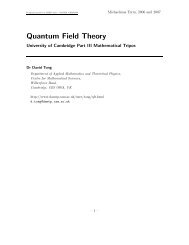CHAPTER 4. THERMODYNAMICS: THE FIRST LAW
CHAPTER 4. THERMODYNAMICS: THE FIRST LAW
CHAPTER 4. THERMODYNAMICS: THE FIRST LAW
You also want an ePaper? Increase the reach of your titles
YUMPU automatically turns print PDFs into web optimized ePapers that Google loves.
4-9<br />
!3<br />
= 30.8 kJ/mol - (8.314x10 kJ/mol-K)(353.2 K) = 27.9 kJ/mol.<br />
E. Heat capacity<br />
The amount of heat released or absorbed in a process may be determined by measuring the<br />
change in temperature of a mass in thermal contact with the process. The heat capacity is defined<br />
as the change in heat divided by the change in temperature, C = dq/dT. However, this definition is<br />
not very useful unless a path is specified, since the value of dq depends on how the process is carried<br />
out. In the laboratory, there are two convenient paths; the constant volume path, where a reaction<br />
is carried out in a closed container so that the volume cannot change, and the constant pressure path,<br />
where a reaction is carried out in an open container so that the pressure remains constant at the<br />
pressure of the surrounding atmosphere. Consider a process carried out at constant volume. Then<br />
dw = 0 and so dq = dU, therefore, the heat capacity (per mole) at constant volume is<br />
and<br />
,<br />
.<br />
For a process carried out at constant pressure, dq = dH, therefore, the heat capacity (per mole) at<br />
constant pressure is<br />
,<br />
and<br />
.<br />
Physically, the difference between C V and C P is related to the fact that when the volume is

















